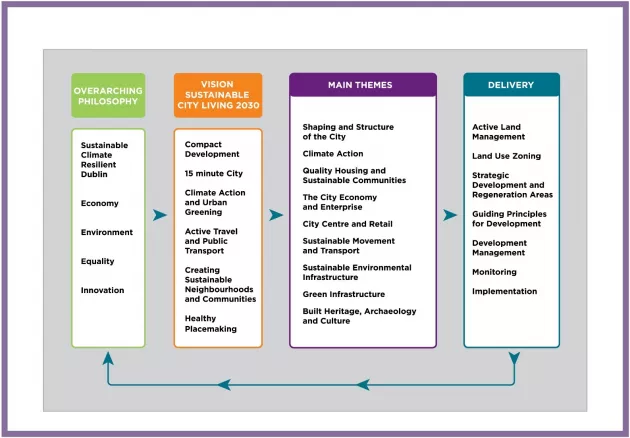1.2 - Strategic Approach – Achieving a Sustainable, Climate Resilient Dublin
1.2 - Strategic Approach – Achieving a Sustainable, Climate Resilient Dublin
The development plan sets out the strategic approach to meet the needs and aspirations of citizens of Dublin and the country, not only for the six-year life of the plan, but for the long term.
The overarching strategic approach of the plan is to develop a low carbon, sustainable, climate resilient city. The costly implications of not doing so are indisputable and the benefits of a more sustainable city are numerous. A shift in behavioural patterns, effective use of land well served by public transport, use of renewable energy sources and development of sustainable infrastructure is critical for the city to make its contribution to emissions reduction and to increase the resilience of the city’s economy. Dublin has made some good progress in these areas, but the scale of the challenge is such that there is a need for a coherent and strategic response.
It is envisaged that by 2050, Dublin will be a zero carbon city with all of its energy coming from renewable energy sources. All of the city’s buildings will have been built or retrofitted to near zero energy building standards, which will provide comfortable, warm, living and working environments. The use of ‘conventionally-fuelled’ cars in urban transport will be halved by 2030 and phased out by 2050 and we will achieve essentially CO2-free city logistics in Dublin by 2030.
Strategic Principles
In achieving a more sustainable and resilient city, the application of the strategic principles at all levels, from plan making to urban projects and development management, will help to deliver a better quality of life for all. The principles which are set out below constitute inter-related and essential elements of a sustainable approach to future development of the city. These principles are imbued throughout the development plan, cascading from the vision, core strategy, policies, objectives and standards through to implementation.
- Social/Residential – creating a more compact city with a network of sustainable neighbourhoods (aligned with the principle of the 15 minute city) which have a range of facilities and a choice of tenure and house types, promoting social inclusion and integration of all ethnic/minority communities.
- Economic – continuing to develop Dublin as the engine of the Irish economy and the national gateway at the heart of the Dublin region, with a network of thriving spatial and sectoral clusters providing the strategic focus for employment and innovation.
- Sustainable Movement – helping to build an integrated transport network and encouraging the provision of greater choice of public transport and active travel including walking and cycling.
- Cultural/Built Heritage – making provision for cultural facilities throughout the city and increasing awareness of our cultural and built heritage and promoting safe and active streets through the design of buildings and the public realm.
- Urban Form – creating a connected, legible and liveable city with a distinctive sense of place, based on active streets, quality public spaces and adequate community and civic infrastructure.
- Healthy Placemaking - ensuring quality architecture, urban design and green spaces to provide quality of life and good health and wellbeing for all.
- Innovation - improving the liveability and attractiveness of Dublin as a dynamic, sustainable city that is future ready by embracing innovation and using technology, including Smart City possibilities, to address city challenges and improve quality of life.
These components of the over-arching strategic approach and philosophy for the new development plan have informed the vision for the city, which is elaborated on below.
Figure 1-1 : Strategic Context
